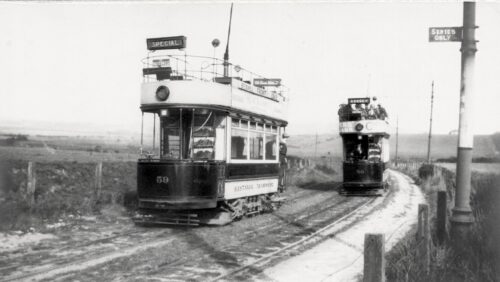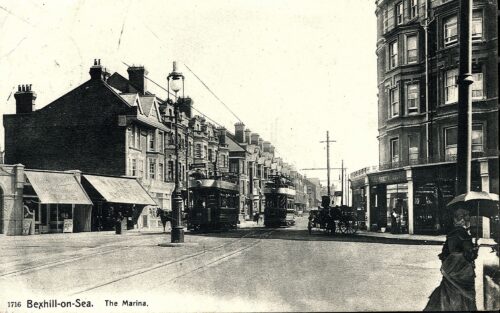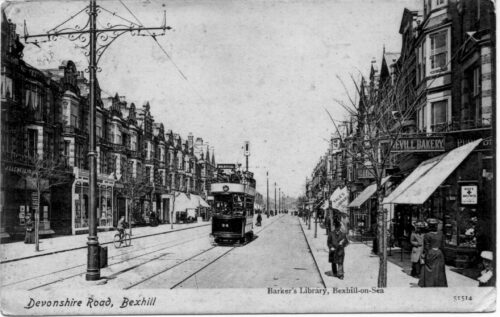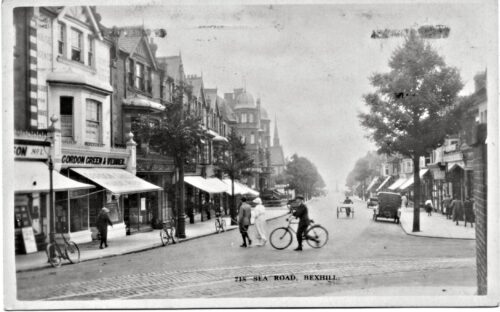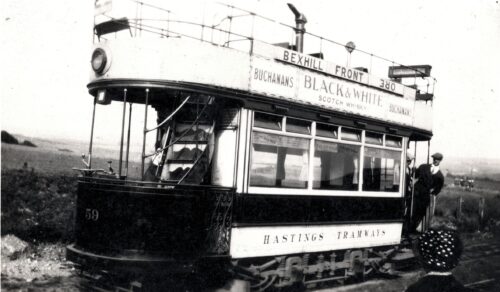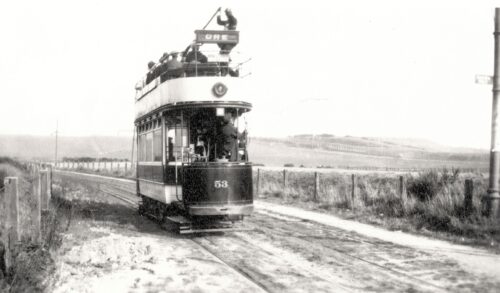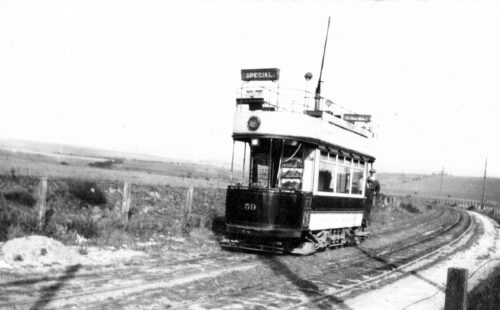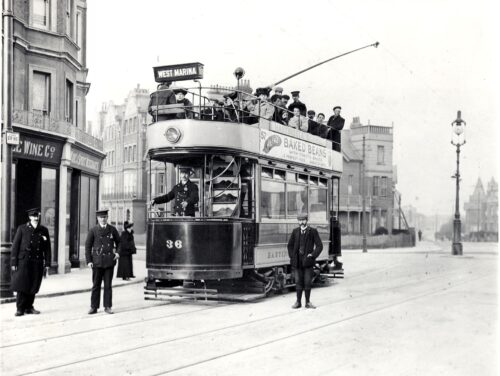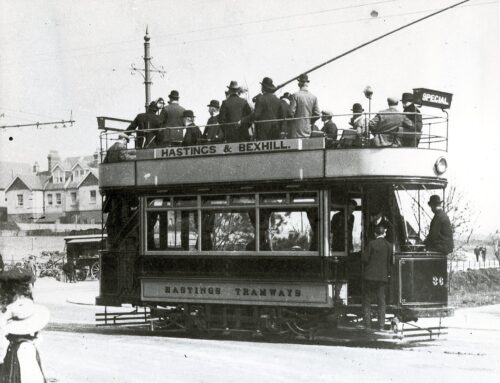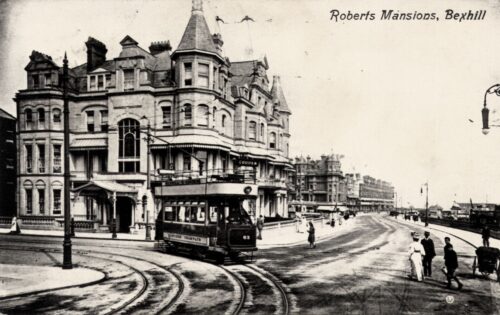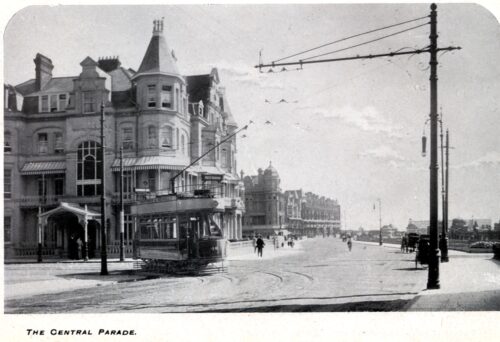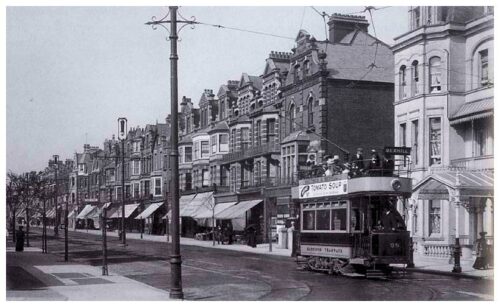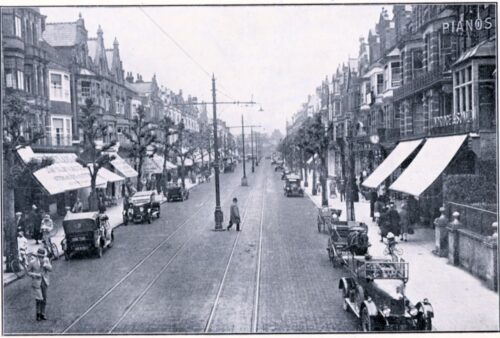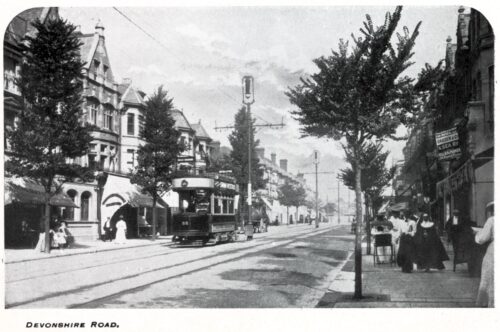The Hastings & District Tramways Company was founded in 1904 and began service in Hastings on July 31st 1905. The Company’s first three tramcars, built in Preston, Lancashire, arrived on the 5th July, 1905, at the Hastings goods railway station.
They were, then, taken to the car station at Silverhill by a traction engine, pulling them up Cambridge Road. Each tramcar was built to carry 42 passengers, 22 outside (on top floor) and 20 inside – they were painted in the Company’s bright new livery; pale yellow and brown, with the words “Hastings Tramways” on the sides.
By the 8th July, another three tramcars were at Battle and three on their way from the Preston works where they were made. The power station off Parker Road, behind Ore railway station, was, then, almost ready to supply the electricity. A trial run was planned for the 12th (but was delayed until 15th); with the service starting on the 20th (this was put back to the 31st). Some members of the public were nervous of this new system, but there had been no accidents at Brighton in the 4½ years of trams there – they had been installed at Brighton by Thomas B Holliday, who was also doing the Hastings service.
After the success of the official “Tram Trial Trip”, on 15th July, from Silverhill to the Memorial in the town centre, on 31st July, 1905, they began running a public service. They used a circular route from the Silverhill depot, via Sedlescombe Road North, the Ridge, Ore, Mount Pleasant, Blacklands, Queens Road, the town centre and Bohemia Road and back to Silverhill (there was a branch line from Silverhill up Battle Road) – 19,000 people used the tram service on the first day.
A branch from Ore to the bottom of Harold Road opened on August 24th 1905, with another branch opening on July 28th 1906, from Silverhill down London Road – a separate Bopeep-Bexhill line opened on April 9th 1906.
The Company’s fleet was to expand to a total of 65 cars; classic, open-top tramcars, having a 5ft 6in wheelbase, on a narrow (3ft 6in) gauge track and built by the United Electric Car Company, in Preston Lancashire.
A second tram depot was built at Bulverhythe and services started between St Leonard’s and Bexhill in April 1906. This line finally reached the isolated outpost (!) of Cooden (then called Kewhurst) in July 1906. The Bexhill section included a length of private tram road across Pebsham Marsh from Egerton Park to Cooden Beach.
The opening of the Bexhill tram service was greeted by the local “Bexhill Observer” with the headlines “After Eight Years”. It seems the original project, of a Bexhill tram service, was born in 1897 when a Mr Murphy approached the Bexhill Council with a view to obtaining their support with his scheme to connect Bexhill and Hastings with the Tramway. In June, 1900, the Bexhill Electric Light Railways was sanctioned by the Board of Trade to go ahead with such a scheme but nothing happened until the Hastings and St Leonard’s Company put their tramway in.
A “Bexhill Observer” newspaper article, dated 14th of June 1906, reported the above, under “History of the Project”, and gave the timetables, fares, and workmen’s fares. It also recorded its first accident, on Monday 16th June, when a tram’s front brakes came off and the wheels left the line! Then, on Wednesday morning, 18th June, while a tram was standing opposite the West Marina Schools, the trolley pole slipped off theb overhead wire and fell on the roof of the car. Several people were hurt and a Mrs Bishopp, of 74 Windsor Road, was more replica watches seriously injured suffering a deep cut on her head and “being rendered unconscious”.
There were other accidents and problems, of course, which at the time, were given greater importance than they would be given after a few more years – for instance, on 28th June 1906 a horse was frightened by a tram and slipped.
The “Bexhill Observer”, in the 28th June issue, however, accidents or not, carried a short article, originally appearing in “The News”, which sums up the feeling of the day.
The electrical system used was a double track “Dolter Stud Contact System” but, by 1913, the Dolter system was considered dangerous and all seafront-running cars were fitted with a petrol engine attached to a dynamo which fed the existing controllers with electricity. The first petrol car ran in 1914 but the petrol experiment didn’t last long and the council allowed over-head wires along the seafront in 1921.
The total length of the Hastings Tramway system reached just short of 20 miles and by September 1926 service numbers were introduced for the following routes:
- Silverhill – St Leonard’s – Ore
- Ore – High Street (Market Cross)
- Bexhill – Ore
- Hollington – Bohemia Road – Memorial
- Ore – Bexhill
- Cooden – St Helens (Cemetery)
- St Helens – Cooden
- Circular via Bohemia Road
- Circular via St Helens
Services 3, 5, 6 and 7 were run in both directions.
The end came in 1927 with the replacement of the trams with trolleybuses. Many of the old tram lines were used to strengthen the concrete blocks along the coast used in the sea defences when the parade extension was built by Sidney Little in the 1930’s.
Note! Two tramcars have survived the many years in between: nos 48 and 56, and both are under restoration by the “Hastings Tramway Club”.
In their issue dated 8th September 1928, the “Bexhill Observer” reported the clearing of the tram standards (the poles that supported the overhead wires) along Devonshire Road, because the trams were being taken out of service and were to be replaced by trolley buses. It, also, shows a picture of the road.


